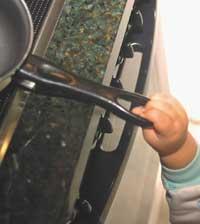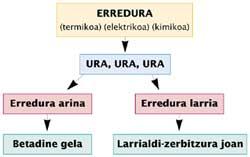Burns at home
The house is a place with high risk of burns

About 60% of the burns treated in hospitals take place at home. That is why it is said that the house is a place of high risk. First, children and older people spend a lot of time at home, and it is precisely the two age groups that are most at risk for burns. On the other hand, potentially dangerous activities at home (kitchen work, hot water baths, corrosive cleaning, etc.) both appliances, heat generators, electricity sources, etc. ).
Who burns at home?
Undoubtedly, children, the elderly and those who play reckless (or, which is the same, reckless) are the ones who burn the most in the domestic environment. And 80% of children under the age of ten who are burned smoke at home. Inside the house, the kitchen and bathroom are the most dangerous.
And it is that the little ones in the house spend a lot of time in the kitchen while the person who cares for them performs their tasks. If to this we add the own curiosity of the child, we will easily understand that the kitchen is a real place of risk.
The child, out of curiosity, may decide to ‘examine’ what is in the burning vessel and, therefore, the one who cooks in it may fall. On other occasions, the fall of the hot liquid on the child is a consequence of the adult's clumsiness, neglect or neglect. Hot liquid burns are the most common in young babies and their severity depends on two factors: the temperature of the liquid and the part of the body in which it has fallen.

On the other hand, in the kitchen are accumulated many appliances that can produce burns in the child. The hot iron left on the table, the roaster on or the oven can produce contact burns or contact, especially in the hands. But also, if the wires of the appliances are not well, their manipulation can cause electric burns on the fingers (even in the mouth, depending on the age of the child). Beware of networked extension devices whose free ends are available to children.
Finally, in most homes it is very normal to store in the kitchen a lot of cleaning products, some of which produce chemical burns in contact with the skin, which will be further aggravated by ingestion. In this case, it is best to call the telephone number of the toxicological institute listed on the label and follow the indications indicated there.
Bathing is also dangerous for the child
At the time we are going to bathe the baby, it is essential to pre-measure the water temperature. If the water is too hot, the child risks causing large burns.
In the bathroom there are usually numerous electrical appliances, whose handling can cause electric burns. Special attention will be paid to wires or extension wires connected on the one hand to the network (if they get into the mouth, the child may suffer severe burns in the mouth, lips or tongue).
Older people are not aware of the risks
The physical and psychic abilities of elderly people are often quite attenuated. Therefore, many of the risks mentioned for boys and girls are also considerable for the elderly.

Other situations that occur with the elderly are the following: it is not uncommon for an older person to fall asleep, who is alone, on a table provided with a source of heat, and that in carelessness the table cloths are laid with a stove or stove.
On other occasions, however, electrical burns are due to the oblivion of a plugged electrical appliance. It often occurs, for example, with electric blankets used to relieve pain. If the person who uses them has reduced sensitivity (quite common in older people), there is a risk that heat will burn that part of the body.
Lack of prudence is ultimately the main cause of burns in both children and the elderly. But adults also go astray.
- Use appliances in poor condition.
- Abrupt opening of the pressure cooker.
- Leave in the heat a pan full of oil.
- Store bleach or other similar corrosive substance in a soda bottle and leave it within reach of children.
- Fresh coffee pouring.
- Try to light the barbecue or fire a fireplace with alcohol.
- Handling of firecrackers and the like.
- … in short, take action without thinking about the conclusions.
What to do immediately after the burn?
First, contact between the smoking agent and the body should be interrupted. To know how to do this, we will consider whether it is hot burns, electricity or chemicals.
- In heat burns, the burned part of the body should cool down. The most effective method for this is the application of abundant water. It is demonstrated that the rapid drop in temperature in the burned area prevents a deeper burn. In these cases it is necessary to keep the burned part for long periods of time in cold waters, which also considerably reduces the pain. If the burn is likely to be brought to an emergency room, it will be covered with a damp cloth and, as soon as possible, go to the doctor. If the burn is mild (by oil or boiling water, by contact with the iron, etc. ), first cool the burned part for a long time and then give it the room Betadine (an antiseptic). This will relieve pain, prevent infections and facilitate skin regeneration. The affected area will then be covered with a clean gas or special dressing. It is recommended to clean the burn daily and apply antiseptic. If in doubt, go to the family doctor who will explain what to do.

- In electric burns, the first step is to cut the contact between the electrical source and the damaged one. And if it has not been done, it is best to cut off electricity. Then
the burned part of the body cools with plenty of water. But always keep in mind that electric burns are in most cases deeper than they seem at first glance. Therefore, if a wound is detected in the burned area, it is advisable to go to emergency services. - When a corrosive chemical has fallen or poured into the surface, it must be removed immediately. To do this, it is best to use water. The longer it takes a burn the better in the water, as the residue of this substance continues to smoke. If the burn is extensive, the eyes or mouth have been burned, or the chemical has been ingested, emergency and prompt service should be provided. Otherwise, once you clean well with water, you can use Betadine or other antiseptic.
Are all burns of the same gravity?

Most home burns do not have a special severity if you know what to do from the first moment. But with some burns you always have to go to the doctor. With whom?
- Extended burn, if wide. When the burned surface exceeds ten palms of the injured.
- If smoke has been breathed during the accident.
- Burns to face, hands, genitals, or feet.
- Electric burns.
- Ingestion of corrosive substances.
- If the injured person has another serious disease (heart, respiratory, diabetes, etc.) ).
In case of doubt, it is better to move the burned person to the nearest emergency room, especially if he is older or younger.





